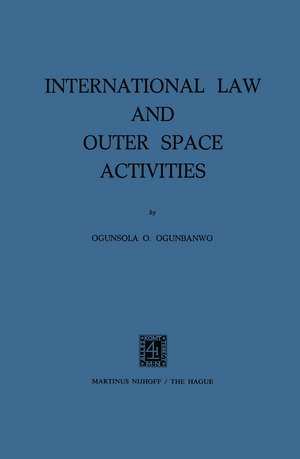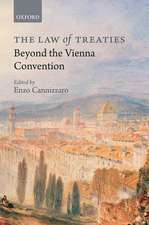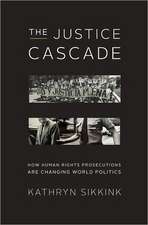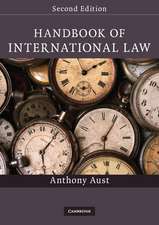International Law and Outer Space Activities
Autor Ogunsola O. Ogunbanwoen Limba Engleză Paperback – 1975
Preț: 388.34 lei
Nou
Puncte Express: 583
Preț estimativ în valută:
74.31€ • 81.04$ • 62.66£
74.31€ • 81.04$ • 62.66£
Carte tipărită la comandă
Livrare economică 24 aprilie-08 mai
Preluare comenzi: 021 569.72.76
Specificații
ISBN-13: 9789401184892
ISBN-10: 9401184895
Pagini: 300
Ilustrații: XXII, 272 p. 1 illus.
Dimensiuni: 155 x 235 x 16 mm
Greutate: 0.42 kg
Ediția:1975
Editura: SPRINGER NETHERLANDS
Colecția Springer
Locul publicării:Dordrecht, Netherlands
ISBN-10: 9401184895
Pagini: 300
Ilustrații: XXII, 272 p. 1 illus.
Dimensiuni: 155 x 235 x 16 mm
Greutate: 0.42 kg
Ediția:1975
Editura: SPRINGER NETHERLANDS
Colecția Springer
Locul publicării:Dordrecht, Netherlands
Public țintă
ResearchCuprins
I Introduction, Purpose and Scope.- I Outer Space Treaty.- II Space Law Before the Space Treaty.- III Definition of Outer Space.- IV Outer Space is the Province of Mankind.- V Jurisdiction over Outer Space.- VI Arms Control and the Space Treaty.- VII Verification Provision.- VIII Treaty Provisions on Safety, Tracking Facilities and Exchange of Information.- IX Final Clauses.- II Assistance and Return Agreement.- X Assistance and Return of Astronauts and the Return of Objects Launched into Outer Space.- III Liability for Damages and the Responsibility of States and International Organizations.- XI Liability for Damages and Responsibility of States and International Organizations.- XII Examples of the “Utilization” of Outer Space (Space Applications).- XIII Trends in International Co-operation.- XIV Concluding Remarks.- Appendices.- A. Treaty Governing the Exploration and Use of Outer Space, Including the Moon and Other Celestial Bodies.- B. Agreement on the Rescue of Astronauts, the Return of Astronauts, and the Return of Objects Launched into Outer Space.- D. Declaration of Legal Principles Governing the Activities of States in the Exploration and Use of Outer Space.- G. Convention on Registration of objects launched into outer space.- H. Treaty Banning Nuclear Weapon Tests in the Atmosphere, in Outer Space and Under Water. Signed in Moscow, on 5 August 1963.- I. Draft Convention on International Liability for Damage Caused by Space Objects (Title, Preamble and Thirteen Articles, as approved by the Legal Sub-Committee at its Ninth Session. 1970).- J. Treaty on the Prohibition of the Emplacement of Nuclear Weapons and Other Weapons of Mass Destruction on the Sea-Bed and the Ocean Floor and in the Subsoil thereof.- K. Resolution adopted by the General Assembly,including the final text of the Convention on International Liability for Damage caused by space objects.- Selected Bibliography.


















